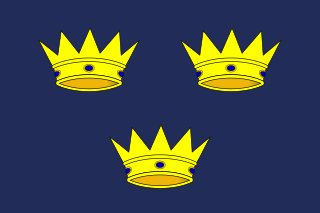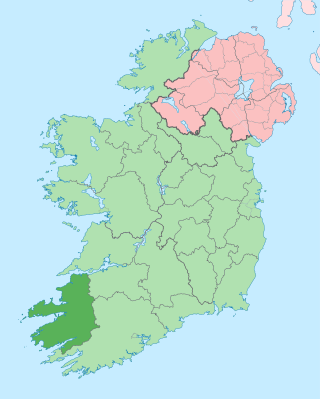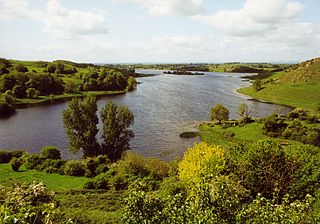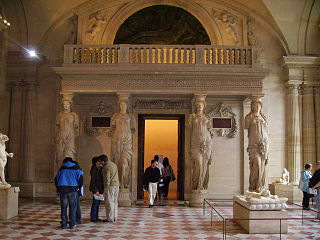
Munster is one of the four provinces of Ireland, located in the south of the island. In early Ireland, the Kingdom of Munster was one of the kingdoms of Gaelic Ireland ruled by a "king of over-kings". Following the Norman invasion of Ireland, the ancient kingdoms were shired into counties for administrative and judicial purposes. In later centuries, local government legislation has seen further sub-division of the historic counties.

County Kerry is a county in Ireland. It is in the Southern Region and the province of Munster. It is named after the Ciarraige who lived in part of the present county. The population of the county was 156,458 at the 2022 census.

Duke of Leinster is a title in the Peerage of Ireland and the premier dukedom in that peerage. The subsidiary titles of the Duke of Leinster are: Marquess of Kildare (1761), Earl of Kildare (1316), Earl of Offaly (1761), Viscount Leinster, of Taplow in the County of Buckingham (1747), Baron of Offaly, Baron Offaly (1620) and Baron Kildare, of Kildare in the County of Kildare (1870). The viscounty of Leinster is in the Peerage of Great Britain, the barony of Kildare in the Peerage of the United Kingdom, and all other titles in the Peerage of Ireland. The courtesy title of the eldest son and heir of the Duke of Leinster is Marquess of Kildare. The Duke of Leinster is the head of the House of Kildare.

The Knight of Glin, also known as the Black Knight or Knight of the Valley, was a hereditary title held by the FitzGerald and FitzMaurice families of County Limerick, Ireland, since the early 14th century. The family was a branch of the FitzMaurice/FitzGerald Dynasty commonly known as the Geraldines and related to the now extinct Earls of Desmond who were granted extensive lands in County Limerick by the Crown. The title was named after the village of Glin, near the Knight's lands. The Knight of Glin was properly addressed as "Knight".

Askeaton is a town in County Limerick, Ireland. The town is built on the banks of the River Deel which flows into the Shannon Estuary 3 km to the north. Askeaton is on the N69 road between Limerick and Tralee; it is 25 km west of Limerick and 8 km north of Rathkeale.

Rathkeale is a town in west County Limerick, in Ireland. It is 30 km (18 mi) southwest of Limerick city on the N21 road to Tralee, County Kerry, and lies on the River Deel. It has a significant Irish Traveller population, and since 1995, almost half the town residents were members of the travelling community. Rathkeale also has the largest concentration of descendants of the German Palatines who immigrated to Ireland in the early 18th century.

Kilmallock is a town in south County Limerick, Ireland, near the border with County Cork. There is a Dominican Priory in the town and King's Castle. The remains of medieval walls which encircled the settlement are still visible.

Newcastle West or simply Newcastle is a town in west County Limerick, Ireland. It is the largest town in the county, excluding Limerick city. It is also the county town, and sits on the River Arra which flows into the River Deel. Newcastle West is in the middle of a great bowl-shaped valley in West Limerick, known one time as the valley of the Wild Boar, apparently due to the abundance of this animal here when the area was thickly wooded. The crest of the town carries the image of a wild boar.

Adare is a village in County Limerick, Ireland, located south-west of the city of Limerick. Adare is designated as a heritage town by the Irish government.

Lough Gur is a lake in County Limerick, Ireland between the towns of Herbertstown and Bruff. The lake forms a horseshoe shape at the base of Knockadoon Hill and some rugged elevated countryside. It is one of Ireland's most important archaeological sites. Humans have lived near Lough Gur since about 3000 BC and there are numerous megalithic remains there.

Powderham Castle is a fortified manor house situated within the parish and former manor of Powderham, within the former hundred of Exminster, Devon, about 6 miles (9.7 km) south of the city of Exeter and 1⁄4 mile (0.4 km) north-east of the village of Kenton, where the main public entrance gates are located. It is a Grade I listed building. The park and gardens are Grade II* listed in the National Register of Historic Parks and Gardens.

The city of Limerick was besieged five times during the 17th century. Two of these sieges took place during the Eleven Years' War. The first of these sieges occurred during the spring of 1642 when Irish Confederate troops besieged and took the town's citadel, King John's Castle from an English Protestant garrison.

A minstrels' gallery is a form of balcony, often inside the great hall of a castle or manor house, and used to allow musicians to perform, sometimes discreetly hidden from the guests below.
Desmond John Villiers FitzGerald, 29th Knight of Glin was an Anglo-Irish hereditary knight, and author. He was the president of the Irish Georgian Society between 1991 and until his death in 2011.

Shanagolden is a small village located in County Limerick, Ireland. The village is on the R521 regional road between Foynes and Newcastlewest, around 35 km west of Limerick City. It is situated west of the 'Golden Vale', an area of fertile agricultural land in the province of Munster. The population was 303 at the 2016 census.

Sir William Courtenay of Powderham in Devon was a prominent member of the Devonshire gentry. He was Sheriff of Devon in 1579–80 and received the rare honour of having been three times elected MP for the prestigious county seat (Devon) in 1584, 1589 and 1601.

Glenquin Castle is a tower house and National Monument located in County Limerick, Ireland.

Askeaton Abbey or Askeaton Friary is a ruined medievalFranciscan friary located north of Askeaton, County Limerick, Ireland, on the east bank of the River Deel.

Oola Castle is a tower house located in County Limerick, Ireland.
Sir George Oughtred Courtenay, 1st Baronet, of Newcastle was an Irish landowner and soldier. He defended Limerick at the siege of 1642 during the Irish Rebellion of 1641.






















